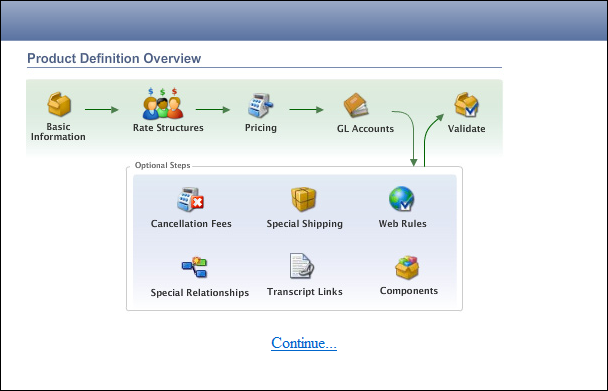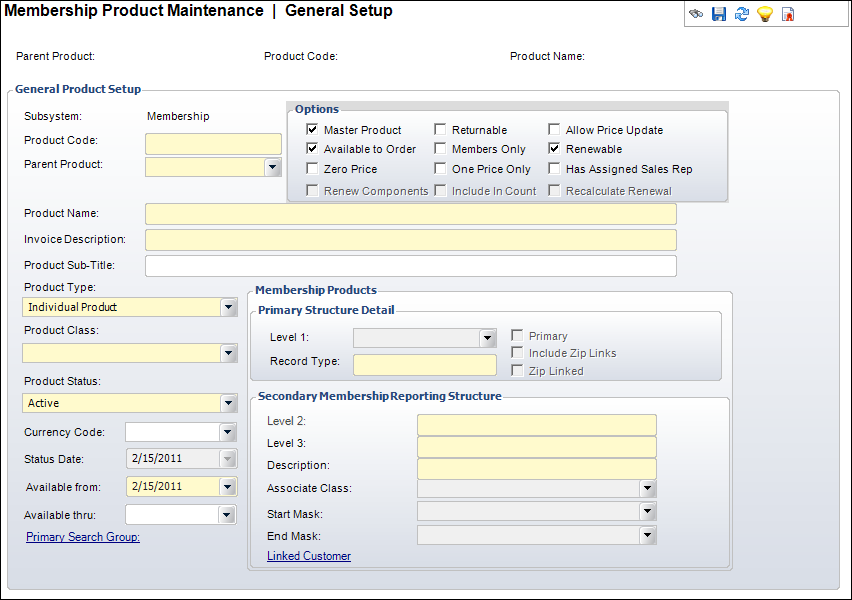The Product Definition Overview displays, as shown below.

To define the general membership product:
1. On
the toolbar, select Membership/Product
Setup > Membership Central.
The Membership Product Maintenance search screen displays.
2. Click Create New Membership Product.
The Product Definition Overview displays, as shown below.

3. Click
the Continue... link.
The General Setup screen displays, as shown below.

4. Enter the Product Code.
5. Select the Parent Product from the drop-down.
6. Enter
the Product Name.
Invoice Description defaults to the same value.
7. Enter a Product Sub-Title (used optionally on the Web).
8. Select the Product Type from the drop-down.
9. Select the Product Class from the drop-down.
10. Select the Product Status from the drop-down.
11. Select the Currency Code from the drop-down.
12. Select the Status Date from the drop-down.
13. Select the Available from date from the drop-down.
 The
Available From date cannot be changed if orders have already been created
for it.
The
Available From date cannot be changed if orders have already been created
for it.
14. If necessary, select the Available thru date from the drop-down.
15. If necessary, click the Primary Search Group link and search for a Primary Search Group to link to the product.
16. Check the applicable checkboxes:
· Master Product
· Available To Order
· Zero Price
· Renew Components
· Returnable
· Members Only
· One Price Only
· Include In Count
· Allow Price Update
· Renewable
· Has Assigned Sales Rep
· Recalculate Renewal
17. In
the Membership Products section, select the Level
1 structure from the drop-down.
The checkboxes are disabled with the selections made in the Membership
Structure section.
18. Click the Level 2 link to search for a Level 2 structure.
19. Enter a Level 3 structure and a Description.
20. If necessary, change a Start Mask and End Mask for the Level 2 structure.
21. To create a cross-reference for the product to a subgroup, click the Linked Customer link and search for a subgroup.
22. Click Save.
Screen Element |
Description |
|---|---|
General Product Setup |
|
Subsystem |
Read-only. The area, or module, with which the product is associated. |
Product Code |
Text box. This is the membership product name. |
Parent Product |
Drop-down. This is the master member group to which the membership product is being added. |
Product Name |
Text box. Describes the membership product name. This is an alphanumeric field with approximately 120 characters. |
Invoice Description |
Text box. Defaults to the Product Name. If your Product Name is extraordinary long, you can edit the Invoice Description to 50 characters. If the Invoice Description is longer than 50 characters, it will be cropped off the invoice. |
Product Sub-Title |
Text box. This sub-title of the product is used optionally on the Web. |
Product Type |
Drop-down. The primary type of product. The following values are populated based on the PRODUCT_TYPE fixed system type:
|
Product Class |
Drop-down. Used to classify any membership product to distinguish between dues, donations, and fees. The values are populated by the PRODUCT_CLASS non-fixed system type. |
Product Status |
Drop-down. The status of the membership product. For example, Active, Cancelled, or Discontinued. |
Currency |
Drop-down. The appropriate domestic or international currency to use in this subsystem, e.g., German Mark, Japanese Yen, US Dollar. |
Status Date |
Drop-down. System-generated status change date. |
Available from |
Drop-down. Indicates the first date the product can be ordered. Defaults to the system date, but it can be overridden.
|
Available thru |
Drop-down. Indicates the last date the product can be ordered. This field is usually left blank unless there is a specific date on which registrations will close. |
Primary Search Group |
Link. This is an optional feature that allows organizations to assign a search group code to products and customers, so that back-office staff assigned to that primary search group can optionally pre-filter searches for customers or products by their assigned primary search group. Primary search group codes are defined on subgroup customer records and mapped to zip codes. An organization can have customers be automatically assigned to a primary search group based on the zip code of their primary address by setting the "CUS" "AUTOMATIC_SEARCH_GROUP_ASSIGNMENT" application parameter to "Y". |
Options |
|
Master Product |
Checkbox. When checked, indicates this product can be purchased as a standalone product. When unchecked, it restricts the product from being purchased without already having another product, with the same parent product code, in the order. The checkbox defaults to checked when the Product Code and Parent Product code are identical. |
Available to Order |
Checkbox. When checked, indicates that the product is available on the Order Entry screen. The Available from date must be less than or equal to today’s date in order for this checkbox to become enabled.
When “CAC” is selected for the Product Type, this checkbox is disabled because you cannot manually add a CAC product to an order. Instead, it is added automatically to an order based on the number of named associates you are selling. |
Zero Price |
Checkbox. When checked, indicates this product is available for $0, so you can validate the product without entering pricing and GL account information. You still must enter a default rate code.
If shipping charges have been defined for the product, shipping will still be calculated during order entry.
|
Renew Components |
Checkbox. Indicates that any components associated with the active membership product will be renewed when the membership product is renewed. See Defining Components for more information on components. |
Returnable |
Checkbox. When checked, indicates this product can be returned. |
Members Only |
Checkbox. When checked, indicates that only members can buy this membership product. This only pertains to current active members. For more information, see Membership Structure. |
One Price Only |
Checkbox. When checked, indicates pricing cannot be targeted solely to one rate structure and all rate structures receive the same price. Processing time is quicker when the product is available to all purchasers and this checkbox is checked. When unchecked, indicates the rate structures apply to the price of the product. |
Include In Count |
Checkbox. When checked and a Linked Customer has been selected from the Secondary Membership Reporting Structure section, a cross reference is defined for a Membership product and a subgroup record. This is required to include this product in the MBR700 Member Counts process. |
Allow Price Update |
When
checked, allows anyone entering an order to edit the sales amount
directly. A debit/credit memo will NOT be created when the price
is adjusted if this checkbox is checked. When the product is added
to an order, the line status will be PROFORMA. Any components
associated with the product will also be PROFORMA.
When setting up products, this checkbox is typically unchecked to provide a better audit trail. Fundraising donations and exhibits are often checked to avoid the creation of a debit/credit memo, as most organizations will want to report the price as only one financial transaction based on the adjusted price they enter into the Order Entry screen. |
Renewable |
Checkbox. When checked, indicates the active membership product can be renewed. |
Has Assigned Sales Rep |
Checkbox. When checked, indicates this product has a sales representative assigned. |
Recalculate Renewal |
Checkbox. Determines if the renewal should be recalculated from the dues schedules or if it should simply accept last years amounts. This is important for negotiated rates in trade association situations. When a product is renewed and this checkbox is checked, the system looks for the new pricing and applies it to the order. |
Membership Products |
|
Level 1 |
Drop-down. This field is used for reporting purposes to separate the major segments of the membership group. For example, Individuals, Companies, or Chapters. The available values are based on the Level 1 membership structures defined on the Membership Structure Maintenance screen. |
Record Type |
Read-only. The record type defined in the Membership Structure Maintenance screen. This value is used to populate the CUS_Current_Membership_Info table. |
Primary |
Read-only checkbox. Within a structure, it is convenient to designate one value as being primary when describing a customer. The status is based on the Level 1 membership structure defined on the Membership Structure Maintenance screen. |
Include Zip Links |
Read-only checkbox. When this product is purchased, the system automatically includes an zipped mapped products with the same parent product code. The status is based on the Level 1 membership structure defined on the Membership Structure Maintenance screen. |
Zip Linked |
Read-only checkbox. This product contains a zip mapping to allow an automatic population of the order record with an appropriate chapter. The status is based on the Level 1 membership structure defined on the Membership Structure Maintenance screen. |
Level 2 |
Link. The available values are based on the previously-entered Level 2 codes. Values can also be entered directly. Level 2 further defines the Level 1 code for reporting purposes. Examples of Level 2 values based on the Level 1 examples include:
|
Level 3 |
Text box. This further defines the Level 2 code for reporting purposes. The value must be unique within the Level 2 grouping. Examples of Level 3 values based on the Level 2 examples include:
|
Description |
Text box. This field displays the value previously entered for the Product Code, which should be a cohesive description of the Level 1, 2, and 3 categories. |
Associate Class |
Drop-down. The type of associate. This field is not often used, but trade associations may find it useful. This field will be disabled unless “Associate” is chosen from the Product Type drop-down. The values are populated based on the ASSOCIATE_CLASS non-fixed system type. |
Start Mask |
Drop-down. The start mask at the membership product level that controls the logic used by the system to set the start date on new membership orders. This defaults to the selection from the Membership Structure Definition screen. For more information, please see Creating a Member Group. |
Default End Mask |
Drop-down. The end mask at the membership product level that controls the logic used by the system to set the end date on new membership orders. This defaults to the selection from the Membership Structure Definition screen. For more information, please see Creating a Member Group. This value sets the Cycle_End_Date.
In addition, this end mask will look at the Length in Months field found on the Rate Code Extension screen. If you have a value that is less than “12” in the Length in Months field, the membership period will reflect a shorter term. For example, if you have a start mask of First of the Month and end mask One Year Plus, and a Length in Months of 6, the membrship start date will be 11/1/2012 and end date will be 4/30/2013. |
Linked Customer |
Link. When clicked, a cross reference is defined for a Membership product and a subgroup record. A value is needed here for MBR700 to work. On the Subgroups screen, this value must exist to calculate the membership total. Multiple products can be linked to the same subgroup product. Typically used to define a cross-reference for chapter products. |